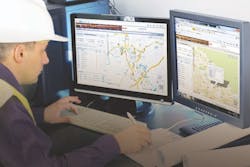Special Section - Meter Source: The Data Advantage
About the author: Jack Merrell is senior marketing manager for Itron. Merrell can be reached at [email protected] or 919.582.1160.
Water is visible around every corner—rivers, lakes, oceans —yet in reality, given unprecedented drought conditions in the U.S. and around the world, we can’t afford to waste one drop. It can be easy to take water for granted. The expectation is that water will be there when we need it with the twist of a knob. But what if it was not? What if, as a result of a continuing increase in demand, coupled with prolonged droughts, the supply was not guaranteed?
That is where we find ourselves today. With large fluctuations in weather patterns and populations on the rise, the availability of precious water resources is not what it would appear to be. In fact, according to the International Water Assn., 25% to 50% of the total water supply in the world (75% in emerging markets) is lost due to leaks and aging infrastructure.
As a result, utilities are faced with the challenge of continuing to provide a quality product and service, while at the same time ensuring the sustainability of a finite resource. To be successful, utilities need data and information, which is where technology comes in.
AMI & Data
Advanced Metering Infrastructure (AMI) solutions make it possible to collect large amounts of data associated with managing meters and measuring customer consumption. This allows utilities to monitor the integrity of distribution systems and track consumer compliance with conservation initiatives. The key to these systems is the ability to apply powerful analytics to the data. Data create awareness, and from awareness can come action. Actions can have an impact on how a utility services its customers, how those customers consume a resource and how that resource is sustained beyond its forecasted availability.
There are a few important steps utilities can take to make this possible.
The first step is to deploy a network that connects meters and sensors, and ensures the reliable, accurate and secure collection of hourly interval data from every meter in a utility’s service territory, including residential, commercial, industrial and district meters. This information provides visibility into every drop that is delivered, as well as every drop that is lost due to system leaks, aging assets or theft. By applying analytics and effective reporting, comparing the amount of supply that is delivered to an area to the amount of supply that is actually consumed (i.e., metered), a utility can very quickly identify the location within its service territory where the potential system losses exist. This is known as district metering.
The next step is to use these same interval data to proactively identify customer-side leaks that result in unnecessary waste, unneeded consumption and high bill complaint calls. With access to hourly interval data, the utility is able to gain understanding into not only how much water is being consumed, but also when consumption occurs. This is invaluable in identifying potential customer-side leaks as well as better understanding customer demands for water.
Another step to achieving water efficiency is proactive leak detection with the help of acoustic leak sensors, which allow utilities to find leaks before they come to the surface. Acoustic leak sensors monitor the health of a distribution system around the clock, “seeing” what can’t be seen. The sensors listen for sounds (the result of vibrations created by water moving through the pipes) and then software manages that information, deciphering what is potentially a true leak versus something that might only appear to be one (e.g., street traffic, appliances in the home). It is not just knowing about the leaks that makes a difference, but also knowing which ones to address first based on their location or duration, for example. Having that information makes it possible to prioritize efforts to ensure utility resources are utilized in the most efficient and effective way possible. The result: Operational costs are lowered and a valuable resource is conserved.
Lastly, conservation programs are another way to save water supplies. Designing, implementing and governing conservation programs can be costly and the success of those efforts can be difficult to fully validate. In the absence of technology, utilities are reliant upon physical manpower to govern whether watering schedules—a key component of conservation programs—are being followed. Capturing when water is being consumed can be just as important as knowing how much. With accurate data collection, coupled with effective analytical tools, utilities are equipped to monitor customer usage on a daily and hourly basis, making it possible to efficiently manage conservation efforts. In addition, this information makes it possible for utilities to validate the success of such efforts, a key determinant as to whether current programs continue or new ones are implemented.
Sometimes efforts to save water are too costly to put in place, enforce or validate. By implementing technologies that facilitate the collection of data, utilities are equipped to establish program goals, measure progress and validate results. They can be assured that the investment in time and technology is well worth the cost for a sustainable future.
Download: Here
